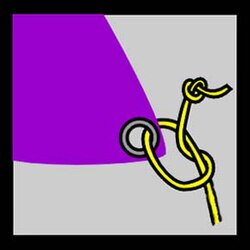NICE!!!



Fairly recently i've started using something similar.
We dive mostly in 20m (60') of water, drifting with the strong currents over reefs, pinnacles or wrecks, spearing yellowtail, either on the bottom or mid-water or around structure.
We started off with floatlines. Problem is that yellowtail swim in schools, so we normally have 3 divers in the water and the 4th keeps the boat close by. Tangling of floatlines was common, but the biggest downfall is that when a shark arrives and we have to get out in a hurry, your floatline ALWAYS seems to be attracted to the boats prop's!!
Next bet, reelguns. The 2.0mm dyneema was simly too thin and slippery to grip AND swim your fish away from an obstruction (reef/wreck/kelp). Bumped it up to 3.0mm and this worked fine. The downside is slow reloading, especially after spearing a fish and slow retrieval of line when a fish has made a long run. Sorting out the tangles just took too long.
We now use a 7m (20') bungee attached to the rear of the gun, with a small pull-under float at the other end. This allows you to spear a fish on or close to a wreck/reef and bully him off it. Should you run out of air, you then have the short 7m (20') bungee, which streches out to 14-15m (50'), to help you!! Been working very, very well!!
Unfortunately, yellowtail are always moving and its rare that the largest fish in the school will be closest to you. Thats why stone shots are very uncommon. Very often, you just surface and hear a gun go off and have to grab a mouthfull of air and get down there to spear a fish in the school. No time for proper breath-up, just gulp some air and dive!! With such limited air, coupled to the excitment, your bottom time is crap, which means many rushed and poorly placed shots!!
With yellowtail, our prime target species, give him an inch of line and he'll wrap you up in the closest obstruction, bending your spear and possibly cutting your shooting line or tearing off.
Please post a pic, as i'd be very keen to rig up one of my guns this way!! Always good to experiment!!

Regards
miles
Fairly recently i've started using something similar.
We dive mostly in 20m (60') of water, drifting with the strong currents over reefs, pinnacles or wrecks, spearing yellowtail, either on the bottom or mid-water or around structure.
We started off with floatlines. Problem is that yellowtail swim in schools, so we normally have 3 divers in the water and the 4th keeps the boat close by. Tangling of floatlines was common, but the biggest downfall is that when a shark arrives and we have to get out in a hurry, your floatline ALWAYS seems to be attracted to the boats prop's!!
Next bet, reelguns. The 2.0mm dyneema was simly too thin and slippery to grip AND swim your fish away from an obstruction (reef/wreck/kelp). Bumped it up to 3.0mm and this worked fine. The downside is slow reloading, especially after spearing a fish and slow retrieval of line when a fish has made a long run. Sorting out the tangles just took too long.
We now use a 7m (20') bungee attached to the rear of the gun, with a small pull-under float at the other end. This allows you to spear a fish on or close to a wreck/reef and bully him off it. Should you run out of air, you then have the short 7m (20') bungee, which streches out to 14-15m (50'), to help you!! Been working very, very well!!
Unfortunately, yellowtail are always moving and its rare that the largest fish in the school will be closest to you. Thats why stone shots are very uncommon. Very often, you just surface and hear a gun go off and have to grab a mouthfull of air and get down there to spear a fish in the school. No time for proper breath-up, just gulp some air and dive!! With such limited air, coupled to the excitment, your bottom time is crap, which means many rushed and poorly placed shots!!
With yellowtail, our prime target species, give him an inch of line and he'll wrap you up in the closest obstruction, bending your spear and possibly cutting your shooting line or tearing off.
Please post a pic, as i'd be very keen to rig up one of my guns this way!! Always good to experiment!!
Regards
miles






